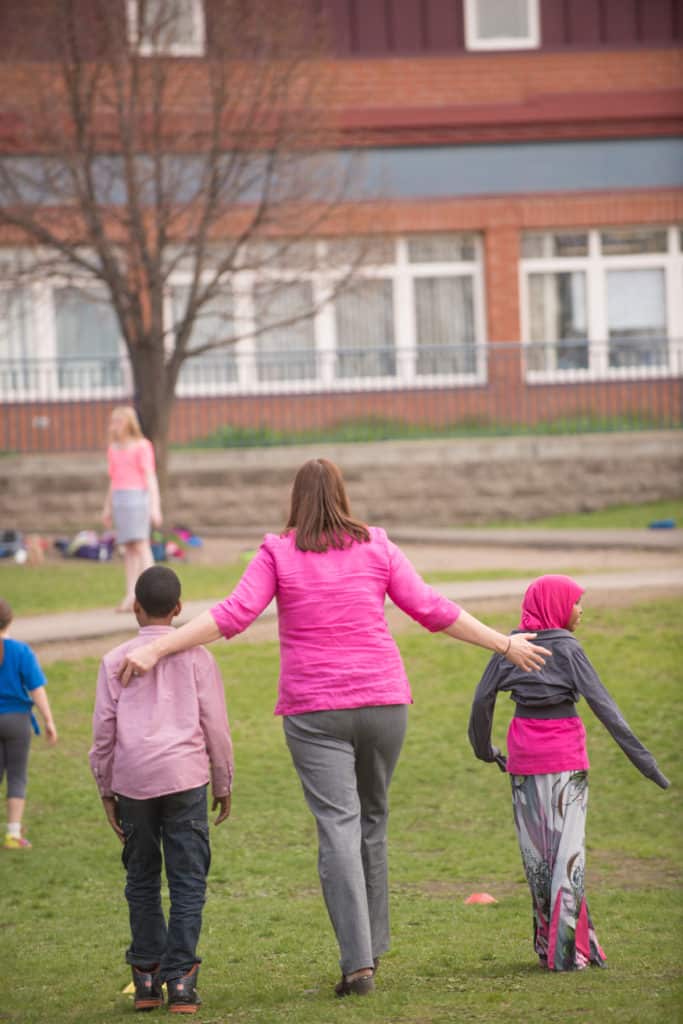
“You can see our school from the bridge,” a fifth grader proudly points out about the recently renovated Regional Multicultural Magnet School (RMMS). Built into a hill overlooking the New London waterfront, RMMS is indeed visible from the bridge that spans the harbor below. The handsome building combines a historic stone structure with a dramatic brick and glass addition. The result is a permanent home for this vibrant K–5 school, which draws students from twelve districts in southeastern Connecticut.
RMMS’s journey to its present setting included moving the entire school to temporary quarters in a nearby town in 2001 to allow renovations to proceed, moving back in January 2004 to use part of the building while renovations were being completed in the rest, and finally spreading out to occupy the entire building in April 2004. One might expect memories of those years to be filled with turmoil and chaos. But when two fifth graders were asked what they remember about the moves, they have few stories to tell. It all seemed like a non-issue to them.
Sally Myers, on the faculty since the school opened in 1991 and now its curriculum coordinator, is not surprised. She explains that the adults worked hard to make the transitions go smoothly and credits an exceptionally strong sense of community for making it all possible. Though the physical features of a school do affect the quality of school life, ultimately “our culture is our community, not our physical space,” she says. Teacher Kathy Auperin specifically points to the school’s almost ten years of Responsive Classroom implementation as a factor. “We knew how to collaborate. When things weren’t working, we’d ask ourselves and each other, ‘Is there another way?’ We knew how to talk about hard topics and work them through.”
Of course, moving a school three times in three years is no small feat regardless of how strong the culture. Here are some highlights of how the RMMS staff managed the changes.
Moving to the temporary space during the summer of 2001 was a major undertaking. Teacher Sarah Magee remembers “it wasn’t just about leaving the building; it was about leaving New London. A lot of our curriculum had been built around things we could walk to.” It was important to help the children say goodbye. “Before we left, we spent time thinking about what we loved about the school, the building, and New London,” she says. “And we reminded each other, ‘Our friends are not leaving, our friends are still here.’”
Once at the transitional school, the staff came together to address challenges proactively. They opened the building for tours before the school year started so families could visit. Principal Dick Spindler-Virgin initiated a scheduling innovation that was so successful it’s been reprised every year since: He made the first three days of school half days for students so the staff could meet in the afternoons to work through rough spots.
As school got going, the physical layout of the facility, which had been designed to be an open office and warehouse, quickly proved to be one of the biggest issues. For example, with 500 students in a warren of rooms with dividing walls that stopped short of the ceiling, managing noise became a priority. The staff’s solution was to coordinate instruction schoolwide to make quiet times possible.
Then, two and a half years later, parents and other volunteers packed up the school again. RMMS re-opened in New London in January 2004. Students’ winter break was extended by a week so that teachers and staff would have time to unpack and set up completely.
When the children arrived, teachers relied on familiar routines and ways of setting up their classrooms to give them a sense of continuity in their new surroundings. Kathy Auperin recalls, “We had Morning Meeting, the classroom rules were there, the supplies students had learned to use were the same. We really tried to make it so that from the children’s perspective we just kept going.”
Still, there were many new features in the school to learn to navigate, including a cafeteria, a gymnasium, updated bathrooms, and staircases. Adults helped the children learn about using such spaces safely and considerately. For example, classes talked about what safe walking on the stairs would look, sound, and feel like and then watched teachers model the behaviors. Then they practiced, observing each other and improving their skills until everyone agreed that they understood the community’s shared expectations and knew how to meet them.
Three months later, when the renovations were finally complete, that process of modeling and practicing served the community well once again as the school spread into the entire building.
All this effort paid off. By striving for consistency and drawing on skills and routines that were ingrained in its schoolwide culture of caring and cooperation, RMMS was able to make its moves without losing its stride.
Setting: Urban
Grades: K–5
Number of students: 500
% of students eligible for free or reduced-price lunch: 38%
Number of staff: 40 certified teachers, 65 total